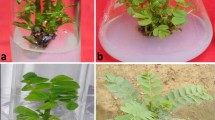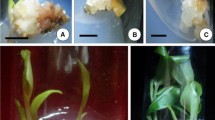Abstract
An efficient micropropagation technique by axillary bud multiplication was established for cloning tetraploid black locust tree (Robinia pseudoacacia L.). The result showed that the optimal medium for shoot multiplication and elongation was Murashige and Skoog (MS) medium supplemented with 0.5 mg/l 6-benzylaminopurine in combination with 0.5 mg/l kinetin and 0.1 mg/l 1-naphthaleneacetic acid. The best medium for rooting was half-strength MS medium with 0.25 mg/l indole-3-butyric acid. In the present report, we examined the genetic fidelity of the micropropagated plants by the randomly amplified polymorphic DNA (RAPD) method with 25 primers. The cloned plants of tetraploid black locust showed complete stability.




Similar content being viewed by others
Abbreviations
- BAP :
-
6-Benzylaminopurine
- GA 3 :
-
Gibberellic acid
- IBA :
-
Indole-3-butyric acid
- KIN :
-
Kinetin
- MS :
-
Murashige and Skoog medium
- NAA :
-
1-Naphthaleneacetic acid
- PCR:
-
Polymerase chain reaction
- RAPD :
-
Randomly amplified polymorphic DNA
References
Barghchi M (1987) Mass clonal propagation in vitro of Robinia pseudoacacia L. (Black locust ) cv. 'Jaszkiseri'. Plant Sci 53:183–189
Cao BH, Long ZR, Liang YT (1993) Study on rapid micropropagation of black locust tree (in Chinese). J Shandong Agric Univ 24:52–61
Chalupa V (1983) In vitro propagation of willow (Salix spp.), European mountain-ash (Sorbus aucuparia L.), and black locust (Robinia pseudoacacia L.). Biol Plant 25:305–307
Chalupa V (1987) Effect of benzylaminopurine and thidiazuron on in vitro shoot proliferation of Tilia cordata Mill., Sorbus aucuparia L. and Robinia pseudoacacia L. Biol Plant 29:425–429
Civinova B, Sladky Z (1990) Stimulation of the regeneration capacity of tree shoot segment explants in vitro. Biol Plant 32:407–413
DeGomez T, Wagner MR (2001) Culture and use of black locust. HortTechnology 11:279–288
Devarumath RM, Nandy S, Rani V, Marimuthu S, Muraleedharan N, Raina SN (2002) RAPD, ISSR and RFLP fingerprints as useful markers to evaluate genetic integrity of micropropagated plants of three diploid and triploid elite tea clones representing Camellia sinensis (China type) and C. assamica ssp. assamica (Assam-India type). Plant Cell Rep 21:166–173. DOI 10.1007/s0029900204962
Guo JZ, Shu QY, Wang LL (2002) The selection and sterilization of explant of tetraploid black locust tree in tissue culture (in Chinese). J Northwest For Univ 17:15–18
Han KH, Keathley DE (1988) Isolation and culture of protoplasts from callus tissue of black locust (Robinia pseudoacacia L.). Nitrogen Fixing Tree Res Rep 6:68–70
Kamlesh K, Sehgal RN, Deepak S (1995) Effect of explant type on the micropropagation of Robinia pseudoacacia. Indian J For 18:47–52
Martin KP (2002) Rapid propagation of Holostemma ada-kodien Schult., a rare medicinal plant, through axillary bud multiplication and indirect organogenesis. Plant Cell Rep 21:112–117. DOI 10.1007/s0029900204837
Merkle SA, Wiecko AT (1989) Regeneration of Robinia pseudoacacia via somatic embryogenesis. Can J For Res 19:285–288
Murashige T, Skoog F (1962) A revised medium for rapid growth and bioassays with tobacco tissue cultures. Physiol Plant 15:473–497
Nickell GL (1982) Kirk-Othmer encyclopaedia of chemical technology, vol 18. Wiley, New York
Rahman MH, Rajora OP (2001) Microsatellite DNA somaclonal variation in micropropagated trembling aspen (Populus tremuloides) Plant Cell Rep 20:531–536
Rani V, Raina SN (1998) Genetic analysis of enhanced-axillary-branching-derived Eucalyptus tereticornis Smith and E. camaldulensis Dehn. plants. Plant Cell Rep 17:236–242
Rani V, Parida A, Raina SN (2001) Chromosome number dependent genome size and RAPD finger-printing diagnostics for genetic integrity of enhanced-axillary-branching-derived plants of ten forest tree species. Acta Hortic 560:531–534
Ren MT (2000) Tetraploid black locust tree (in Chinese). J Shanxi For 3:20
Rogers SO, Bendich AJ (1985) Extraction of DNA from milligram amounts of fresh, herbarium, and mummified plant tissues. Plant Mol Biol 5:69–76
Wang SZ, Tian YT, Luo XF(1999) Tissue culture of the gigas type and tetraploid clone of black locust (in Chinese). Plant Physiol Commun 35:204–205
Wang SZ, Tian YT, Li Y (2002) Study on tissue culture of tetraploid black locust clone (in Chinese). Acta Agriculturae Nucleatae Sinica 16:40–44
Weising K, Nybom H, Wolff K, Meyer W (1995) DNA fingerprinting in plants and fungi. CRC Press, Boca Raton
Woo JH, Choi MS, Park YG (1995) Plant regeneration from callus culture of black locust (Robinia pseudoacacia L.). J Korean For Soc 84:145–150
Acknowledgements
Our special thanks are given to our co-worker Mrs. Fang-fang Li for her technical assistance. The Biotechnology of Pasture Plant Program is funded by the Key Project of the Chinese Academy of Sciences (KSCX1-08).
Author information
Authors and Affiliations
Corresponding author
Additional information
Communicated by M. Beckert
Rights and permissions
About this article
Cite this article
Shu, Q.Y., Liu, G.S., Qi, D.M. et al. An effective method for axillary bud culture and RAPD analysis of cloned plants in tetraploid black locust. Plant Cell Rep 22, 175–180 (2003). https://doi.org/10.1007/s00299-003-0661-2
Received:
Revised:
Accepted:
Published:
Issue Date:
DOI: https://doi.org/10.1007/s00299-003-0661-2




